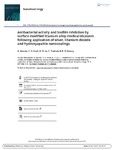Antibacterial activity and biofilm inhibition by surface modified titanium alloy medical implants following application of silver, titanium dioxide and hydroxyapatite nanocoatings
| dc.contributor.author | Besinis, Alexandros | |
| dc.contributor.author | Hadi, SD | |
| dc.contributor.author | Le, HR | |
| dc.contributor.author | Tredwin, Christopher | |
| dc.contributor.author | Handy, Richard | |
| dc.date.accessioned | 2017-04-24T16:21:00Z | |
| dc.date.issued | 2017-03-17 | |
| dc.identifier.issn | 1743-5390 | |
| dc.identifier.issn | 1743-5404 | |
| dc.identifier.uri | http://hdl.handle.net/10026.1/9111 | |
| dc.description | peerreview_statement: The publishing and review policy for this title is described in its Aims & Scope. aims_and_scope_url: http://www.tandfonline.com/action/journalInformation?show=aimsScope&journalCode=inan20 | |
| dc.description.abstract |
One of the most common causes of implant failure is peri-implantitis, which is caused by bacterial biofilm formation on the surfaces of dental implants. Modification of the surface nanotopography has been suggested to affect bacterial adherence to implants. Silver nanoparticles are also known for their antibacterial properties. In this study, titanium alloy implants were surface modified following silver plating, anodisation and sintering techniques to create a combination of silver, titanium dioxide and hydroxyapatite (HA) nanocoatings. Their antibacterial performance was quantitatively assessed by measuring the growth of Streptococcus sanguinis, proportion of live/dead cells and lactate production by the microbes over 24 h. Application of a dual layered silver-HA nanocoating to the surface of implants successfully inhibited bacterial growth in the surrounding media (100% mortality), whereas the formation of bacterial biofilm on the implant surfaces was reduced by 97.5%. Uncoated controls and titanium dioxide nanocoatings showed no antibacterial effect. Both silver and HA nanocoatings were found to be very stable in biological fluids with material loss, as a result of dissolution, to be less than 0.07% for the silver nanocoatings after 24 h in a modified Krebs-Ringer bicarbonate buffer. No dissolution was detected for the HA nanocoatings. Thus, application of a dual layered silver-HA nanocoating to titanium alloy implants creates a surface with antibiofilm properties without compromising the HA biocompatibility required for successful osseointegration and accelerated bone healing. | |
| dc.format.extent | 327-338 | |
| dc.format.medium | Print-Electronic | |
| dc.language | en | |
| dc.language.iso | en | |
| dc.publisher | Informa UK Limited | |
| dc.subject | Biomaterials | |
| dc.subject | nanotopography | |
| dc.subject | nanoparticles | |
| dc.subject | medical microbiology | |
| dc.subject | nanosurfaces | |
| dc.title | Antibacterial activity and biofilm inhibition by surface modified titanium alloy medical implants following application of silver, titanium dioxide and hydroxyapatite nanocoatings | |
| dc.type | journal-article | |
| dc.type | Journal Article | |
| plymouth.author-url | https://www.webofscience.com/api/gateway?GWVersion=2&SrcApp=PARTNER_APP&SrcAuth=LinksAMR&KeyUT=WOS:000399569200003&DestLinkType=FullRecord&DestApp=ALL_WOS&UsrCustomerID=11bb513d99f797142bcfeffcc58ea008 | |
| plymouth.issue | 3 | |
| plymouth.volume | 11 | |
| plymouth.publication-status | Published | |
| plymouth.journal | Nanotoxicology | |
| dc.identifier.doi | 10.1080/17435390.2017.1299890 | |
| plymouth.organisational-group | /Plymouth | |
| plymouth.organisational-group | /Plymouth/Faculty of Health | |
| plymouth.organisational-group | /Plymouth/Faculty of Health/Peninsula Dental School | |
| plymouth.organisational-group | /Plymouth/Faculty of Science and Engineering | |
| plymouth.organisational-group | /Plymouth/Faculty of Science and Engineering/School of Biological and Marine Sciences | |
| plymouth.organisational-group | /Plymouth/Faculty of Science and Engineering/School of Engineering, Computing and Mathematics | |
| plymouth.organisational-group | /Plymouth/REF 2021 Researchers by UoA | |
| plymouth.organisational-group | /Plymouth/REF 2021 Researchers by UoA/UoA03 Allied Health Professions, Dentistry, Nursing and Pharmacy | |
| plymouth.organisational-group | /Plymouth/REF 2021 Researchers by UoA/UoA06 Agriculture, Veterinary and Food Science | |
| plymouth.organisational-group | /Plymouth/REF 2021 Researchers by UoA/UoA12 Engineering | |
| plymouth.organisational-group | /Plymouth/Research Groups | |
| plymouth.organisational-group | /Plymouth/Research Groups/Marine Institute | |
| plymouth.organisational-group | /Plymouth/Users by role | |
| plymouth.organisational-group | /Plymouth/Users by role/Academics | |
| dc.publisher.place | England | |
| dcterms.dateAccepted | 2017-02-21 | |
| dc.identifier.eissn | 1743-5404 | |
| dc.rights.embargoperiod | No embargo | |
| rioxxterms.versionofrecord | 10.1080/17435390.2017.1299890 | |
| rioxxterms.licenseref.uri | http://www.rioxx.net/licenses/all-rights-reserved | |
| rioxxterms.licenseref.startdate | 2017-03-17 | |
| rioxxterms.type | Journal Article/Review | |
| plymouth.oa-location | http://www.tandfonline.com/doi/full/10.1080/17435390.2017.1299890 |


